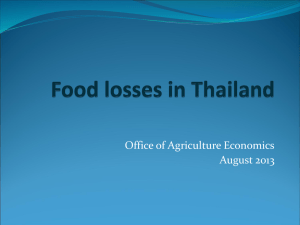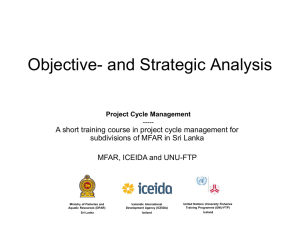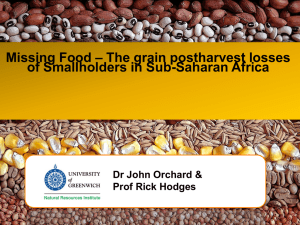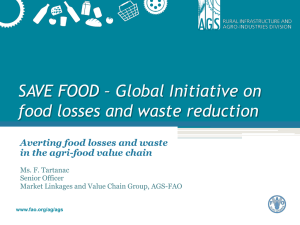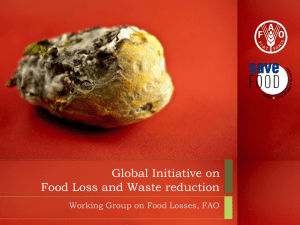Lowering Food Losses on Grain
advertisement
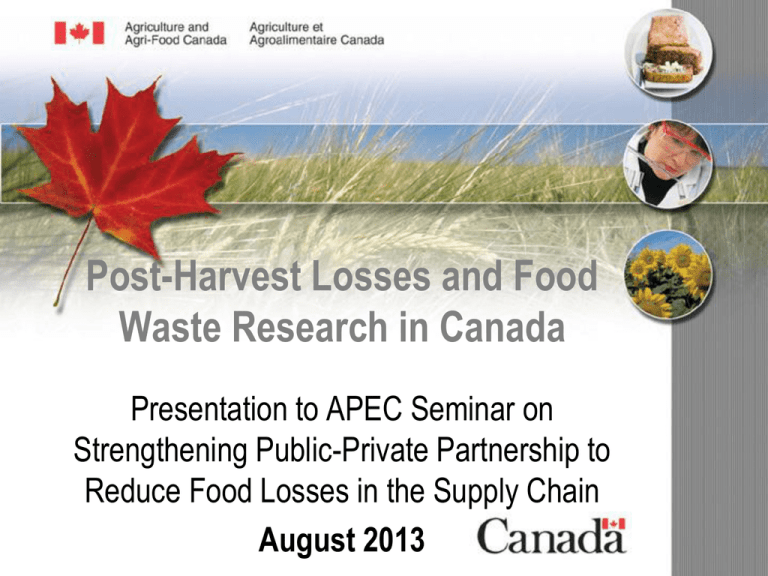
Post-Harvest Losses and Food Waste Research in Canada Presentation to APEC Seminar on Strengthening Public-Private Partnership to Reduce Food Losses in the Supply Chain August 2013 Food Losses and Waste Are An Important Element of Supporting Food Security • Much of the dialogue on food security has focused on improving production and productivity • However, mounting evidence suggests that the world supplies sufficient food, but 30-40% is lost or wasted – In developing nations, it is estimated that most food losses happen postharvest, between harvest and retail – In developed nations, it is estimated that most food waste is due to consumer waste, much of this suitable for human consumption • Reducing food losses and waste is an opportunity to increase the available supply of food 2 Reducing Food Losses in the Early Stages of the Food System • Much of the attention on food losses and waste is centered around innovations in storage, transportation, infrastructure • In addition to losses during storage, Canadian scientists have looked at means to reduce food losses at earlier stages of the food system – production and harvest, where scientists research 4 categories: i. ii. iii. iv. Intrinsic characteristics of the product that improves resiliency Practices employed in the field and post-harvest Additives that inhibit ripening and decay Technology use • Research related to losses in grains focuses primarily on the first, second and fourth of these categories 3 Intrinsic Characteristics of the Product • Pre-harvest sprouting (PHS) in grain is caused when grains have reached maturity but are negatively affected by rains before harvest. PHS creates waste/losses by reducing grain yield and suitability for food processing. In Canada, this can result in about $100million in lost market value 3 out of 10 years. • Scientists undertake genetic research on PHS-resistant characteristics in grains to pursue improved cultivars • Scientists also study methods for measuring factors that contribute to PHS (e.g. dormancy) 4 Intrinsic Characteristics of the Product cont’d • Disease and insect damage in grains can cause serious losses • Grains with increased resiliency will result in reduced losses • Breeding for resiliency against diseases and insects is ongoing in Canada – Diseases: fusarium head blight and associated mycotoxin (DON), leaf and stem rust, common bunt, crown rust, ergot, and leaf spot – Insects: wheat stem sawfly, orange wheat blossom midge 5 Practices Associated with Storage • Potentially cost-effective practices can be an important means to reduce food losses and waste during storage • Examples of Canadian research: – Aeration of grain with air/liquid nitrogen to freeze insects – Use of microwaves to control beetles in grains and pulses – Use of short-wave near-infrared hyperspectral and digital colour imaging to detect fungal damage, insect damage • One can calibrate inexpensive near-infrared apparatus for specific characteristics 6 Inhibition of Ripening and Decay (associated with fruits and vegetables rather than grains) • Studies have been completed in preventing physical decay and disease in fruits and vegetables – Use of 1-methylcyclopropene, ethylene, ozone, and antimicrobials as possible ripening inhibitors. – Use of reflective tarps during harvest to extend life – Lactic fermentation and biological agents to delay decay • The first option is particularly useful for fruits that are sensitive to chilling and might be broadened to sub-tropical and tropical fruits (e.g. banana, avocado, durian, guava, jackfruit, mango, etc.) • The second 2 options could be of significant importance in hot climates 7 Use of Cost-Effective Technology • Some technologies can dramatically reduce food losses and waste and can be quite cost-effective – Use of instruments to detect insects, moulds and mycotoxins (traps, odour detection) – Weather-tight bins to keep grain dry – Aeration after harvest to dry and cool grains – Use of “sensor arrays” to identify specific sources of spoilage (Temperature and moisture sensors will soon be developed as well as nanosensors for odours) 8 Public – Private Partnerships • At Agriculture and Agri-Food Canada (AAFC), funding programs are available to support collaborations between AAFC scientists, other public agencies and the private sector • For example, industry-based organizations, like the Canola Council and Western Grains Research Foundation can partner with universities and AAFC to research topics that will lend to reduction of losses and waste • This approach can be effective in meeting industry goals by capitalizing on the strengths within each sector 9 Conclusions • When discussing food losses and waste, we need to look at a broader spectrum of possible options (e.g. more resilient varieties) rather than just post-harvest • Canadian scientists have concluded that improvements to production, harvest, and storage processes can help to reduce waste and post-harvest losses • This research is adaptable to production systems in both developing and developed economies • Public – private partnerships, through funding programs, can be effective in the development of innovative ways to reduce losses 10 For Further Information • Canadian scientists working in both grains and horticulture fields would be happy to discuss their post-harvest and resiliency work with you in greater detail • For more information on scientists working these fields, please contact: Diane Livingston Email: diane.livingston@agr.gc.ca Telephone: 1 (306) 523-6568 11

